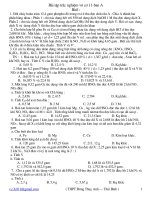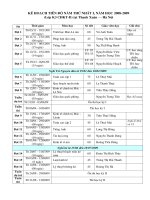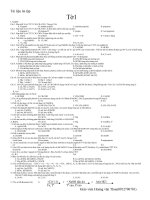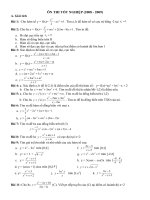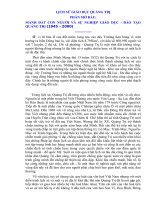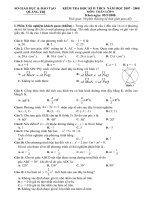ch11ex btap ktoan qtri
Bạn đang xem bản rút gọn của tài liệu. Xem và tải ngay bản đầy đủ của tài liệu tại đây (413.34 KB, 6 trang )
Exercises: Set B
o l l e g e/ w
/c
www
.
Exercises: Set B
1
g a n dt
wi
ey
ley.co m
E11-1B Baffet Company is planning to produce 2,000 units of product in 2011. Each
unit requires 2.5 pounds of materials at $5 per pound and a half hour of labor at $16
per hour. The overhead rate is 70% of direct labor.
Compute budget and
standard.
(SO 1, 2, 3)
Instructions
(a) Compute the budgeted amounts for 2011 for direct materials to be used, direct labor,
and applied overhead.
(b) Compute the standard cost of one unit of product.
(c) What are the potential advantages to a corporation of using standard costs?
E11-2B Victor Pallini manufactures and sells homemade wine, and he wants to
develop a standard cost per gallon. The following are required for production of a
50-gallon batch.
Compute standard materials
costs.
(SO 3)
3,300 ounces of grape concentrate at $0.08 per ounce
54 pounds of granulated sugar at $0.30 per pound
60 lemons at $0.66 each
50 yeast tablets at $0.25 each
50 nutrient tablets at $0.20 each
2,500 ounces of water at $0.004 per ounce
Victor estimates that 4% of the grape concentrate is wasted, 10% of the sugar is lost, and
20% of the lemons cannot be used.
Instructions
Compute the standard cost of the ingredients for one gallon of wine. (Carry computations to two decimal places.)
E11-3B
Melman Company has gathered the information shown below about its product.
Direct materials: Each unit of product contains 4.5 pounds of materials. The average waste and spoilage per unit produced under normal conditions is 0.5 pounds.
Materials cost $3 per pound, but Melman always takes the 1% cash discount all of
its suppliers offer. Freight costs average $0.25 per pound.
Compute standard cost
per unit.
(SO 3)
Direct labor: Each unit requires 2 hours of labor. Setup, cleanup, and downtime
average 0.2 hours per unit. The average hourly pay rate of Melman’s employees is
$10. Payroll taxes and fringe benfits are an additional $3 per hour.
Manufacturing overhead: Overhead is applied at a rate of $6 per direct labor hour.
Instructions
Compute Melman’s total standard cost per unit.
E11-4B Phast Repair Services, Inc. is trying to establish the standard labor cost of a
typical oil change. The following data have been collected from time and motion studies
conducted over the past month.
Actual time spent on the oil change
Hourly wage rate
Payroll taxes
Setup and downtime
Cleanup and rest periods
Fringe benefits
Compute labor quantity
variance.
(SO 3, 4)
.9 hour
$12
12% of wage rate
10% of actual labor time
30% of actual labor time
25% of wage rate
Instructions
(a) Determine the standard direct labor hours per oil change.
(b) Determine the standard direct labor hourly rate.
(c) Determine the standard direct labor cost per oil change.
(d) If an oil change took 1.3 hours at the standard hourly rate, what was the direct
labor quantity variance?
E11-5B The standard cost of Product B manufactured by Hajj Company includes two
units of direct materials at $4.00 per unit. During June, 27,000 units of direct materials
are purchased at a cost of $3.80 per unit, and 27,000 units of direct materials are used
to produce 13,000 units of Product B.
Compute materials price
and quantity variances.
(SO 4)
2
chapter 11 Standard Costs and Balanced Scorecard
Instructions
(a) Compute the total materials variance and the price and quantity variances.
(b) Repeat (a), assuming the purchase price is $4.20 and the quantity purchased and
used is 25,200 units.
Compute labor price and
quantity variances.
(SO 4)
E11-6B Cobb Company’s standard labor cost of producing one unit of Product DD is
3 hours at the rate of $10.00 per hour. During August, 30,500 hours of labor are incurred
at a cost of $10.10 per hour to produce 10,000 units of Product DD.
Instructions
(a) Compute the total labor variance.
(b) Compute the labor price and quantity variances.
(c) Repeat (b), assuming the standard is 3.2 hours of direct labor at $10.20 per hour.
Compute materials and
labor variances.
E11-7B Hector Inc., which produces a single product, has prepared the following standard cost sheet for one unit of the product.
(SO 4)
Direct materials (6 pounds at $2.50 per pound)
Direct labor (3.1 hours at $12.00 per hour)
$15.00
$37.20
During the month of April, the company manufactures 250 units and incurs the following actual costs.
Direct materials purchased and used (1,600 pounds)
Direct labor (760 hours)
$4,192
$8,740
Instructions
Compute the total, price, and quantity variances for materials and labor.
Compute the materials and
labor variances and list
reasons for unfavorable
variances.
(SO 4, 6)
E11-8B The following direct materials and direct labor data pertain to the operations
of Hsang Manufacturing Company for the month of August.
Costs
Quantities
Actual labor rate
$13 per hour
Actual materials price
$89 per ton
Standard labor rate
Standard materials price
$12 per hour
$90 per ton
Actual hours incurred
and used
Actual quantity of
materials purchased
and used
Standard hours used
Standard quantity of
materials used
3,200 hours
910 tons
3,240 hours
900 tons
Instructions
(a) Compute the total, price, and quantity variances for materials and labor.
(b)
Provide two possible explanations for each of the unfavorable variances
calculated above, and suggest where responsibility for the unfavorable result might
be placed.
Determine amounts from
variance report.
(SO 4)
E11-9B You have been given the following information about the production of Delta
Co., and are asked to provide the plant manager with information for a meeting with the
vice president of operations.
Standard Cost Card
Direct materials (6 pounds at $3 per pound)
Direct labor (0.8 hours at $5)
Variable overhead (0.8 hours at $3 per hour)
Fixed overhead (0.8 hours at $7 per hour)
$18.00
4.00
2.40
5.60
$30.00
Exercises: Set B
3
The following is a production report for the most recent period of operations.
Variances
Costs
Total Standard Cost
Price
Quantity
Direct materials
Direct labor
$396,000
90,000
$6,450 U
3,320 U
$9,000 F
7,000 F
Instructions
(a) How many units were produced during the period?
(b) How many pounds of raw material were purchased and used during the period?
(c) What was the actual cost per pound of raw materials?
(d) How many actual direct labor hours were worked during the period?
(e) What was the actual rate paid per direct labor hour?
(CGA adapted)
E11-10B During March 2011, Jason Tool & Die Company worked on four jobs. A
review of direct labor costs reveals the following summary data.
Actual
Standard
(SO 4, 6)
Job
Number
Hours
Costs
Hours
Costs
Total
Variance
A257
A258
A259
A260
220
450
240
115
$ 5,500
12,150
6,180
2,530
225
430
240
110
$ 5,625
10,750
6,000
2,750
$ 125 F
1,850 U
180 U
220 F
Total variance
Prepare a variance report
for direct labor.
$1,685 U
Analysis reveals that Job A257 was a repeat job. Job A258 was a rush order that required
overtime work at premium rates of pay. Job A259 required a more experienced replacement worker on one shift. Work on Job A260 was done for one day by a new trainee
when a regular worker was absent.
Instructions
Prepare a report for the plant supervisor on direct labor cost variances for March. The report should have columns for (1) Job No., (2) Actual Hours, (3) Standard Hours, (4) Quantity Variance, (5) Actual Rate, (6) Standard Rate, (7) Price Variance, and (8) Explanation.
E11-11B Manufacturing overhead data for the production of Product H by Yamato
Company are as follows.
Overhead incurred for 35,000 actual direct labor hours worked
Overhead rate (variable $3; fixed $1) at normal capacity of 36,000
direct labor hours
Standard hours allowed for work done
Compute overhead variances.
(SO 5)
$140,000
$4
34,000
Instructions
Compute the total overhead variance.
E11-12B Valli Company produces one product, a putter called LO-Putter. Valli uses a
standard cost system and determines that it should take 1.2 hours of direct labor to produce one LO-Putter. The normal production capacity for this putter is 100,000 units per
year. The total budgeted overhead at normal capacity is $1,000,000 comprised of $200,000
of variable costs and $800,000 of fixed costs. Valli applies overhead on the basis of direct
labor hours.
During the current year, Valli produced 90,000 putters, worked 94,000 direct labor
hours, and incurred variable overhead costs of $186,000 and fixed overhead costs of
$800,000.
Instructions
(a) Compute the predetermined variable overhead rate and the predetermined fixed overhead rate.
(b) Compute the applied overhead rate for Valli for the year.
(c) Compute the total overhead variance.
Compute overhead variances.
(SO 5)
4
chapter 11 Standard Costs and Balanced Scorecard
Compute and journalize
variances for materials.
(SO 4, 7)
E11-13B Otay Company purchased (at a cost of $12,800) and used 3,300 pounds
of materials during May. Otay’s standard cost of materials per unit produced is based on
2 pounds per unit at a cost $4 per pound. Production in May was 1,540 units.
Instructions
(a) Compute the total, price, and quantity variances for materials.
(b) Assume Otay also had an unfavorable labor quantity variance. What is a possible scenario that would provide one cause for the variances computed in (a) and the unfavorable labor quantity variance?
Prepare a variance report.
(SO 4, 6)
E11-14B Neighborhood Landscaping plants grass seed as the basic landscaping for
business campuses. During a recent month the company worked on three projects (Ball,
Korman, and Matheny). The company is interested in controlling the material costs,
namely the grass seed, for these plantings projects.
In order to provide management with useful cost control information, the company uses standard costs and prepares monthly variance reports. Analysis reveals that
the purchasing agent mistakenly purchased poor-quality seed for the Ball project. The
Korman project, however, received higher-than-standard-quality seed that was on sale.
The Matheny project received standard-quality seed; however, the price had increased
and a new employee was used to spread the seed.
Shown below are quantity and cost data for each project.
Actual
Standard
Project
Quantity
Costs
Quantity
Costs
Total
Variance
Ball
Korman
Matheny
500 lbs.
400
415
$1,400
1,160
1,328
460 lbs.
410
400
$1,380
1,230
1,200
$ 20 U
70 F
128 U
Total variance
$ 78 U
Instructions
(a) Prepare a variance report for the purchasing department with the following columns:
(1) Project, (2) Actual pounds purchased, (3) Actual price, (4) Standard price, (5) Price
variance, and (6) Explanation.
(b) Prepare a variance report for the production department with the following columns:
(1) Project, (2) Actual pounds, (3) Standard pounds, (4) Standard price, (5) Quantity
variance, and (6) Explanation.
Complete variance report.
E11-15B
(SO 6)
Madiera Corporation prepared the following variance report.
MADIERA CORPORATION
Variance Report—Purchasing Department
for Week Ended January 9, 2012
Type of
Materials
Quantity
Purchased
Actual
Price
Standard
Price
Price
Variance
Explanation
Sand25
Brown36
Green48
? lbs.
5,000 oz.
22,000 units
$5.20
?
0.55
$5.00
4.20
?
$3,000 ?
1,050 U
440 F
Price increase
Rush order
Bought larger quantity
Instructions
Fill in the appropriate amounts or letters for the question marks in the report.
Prepare income statement for
management.
(SO 7)
E11-16B Poway Company uses a standard cost accounting system. During January, the
company reported the following manufacturing variances.
Materials price variance
Materials quantity variance
Labor price variance
$2,250 U
700 F
525 U
Labor quantity variance
Overhead variance
$725 U
500 U
In addition, 6,000 units of product were sold at $8 per unit. Each unit sold had a standard cost of $6. Selling and administrative expenses were $6,500 for the month.
Instructions
Prepare an income statement for management for the month ended January 31, 2011.
Exercises: Set B
*E11-17B Ysidro Company installed a standard cost system on January 1. Selected transactions for the month of January are as follows.
1. Purchased 24,000 units of raw materials on account at a cost of $4.50 per unit. Standard cost was $4.30 per unit.
2. Issued 24,000 units of raw materials for jobs that required 23,500 standard units of
raw materials.
3. Incurred 20,400 actual hours of direct labor at an actual rate of $4.80 per hour. The
standard rate is $5.50 per hour. (Credit Wages Payable)
4. Performed 20,400 hours of direct labor on jobs when standard hours were 20,600.
5. Applied overhead to jobs at the rate of 100% of direct labor cost for standard hours
allowed.
5
Journalize entries in a
standard cost accounting
system.
(SO 9)
Instructions
Journalize the January transactions.
*E11-18B Yeung Company uses a standard cost accounting system. Some of the ledger
accounts have been destroyed in a fire. The controller asks your help in reconstructing
some missing entries and balances.
Answer questions concerning
missing entries and balances.
(SO 4, 5, 9)
Instructions
Answer the following questions.
(a) Materials Price Variance shows a $3,000 favorable balance. Accounts Payable shows
$148,000 of raw materials purchases. What was the amount debited to Raw Materials
Inventory for raw materials purchased?
(b) Materials Quantity Variance shows a $3,000 unfavorable balance. Raw Materials
Inventory shows a zero balance. What was the amount debited to Work in Process
Inventory for direct materials used?
(c) Labor Price Variance shows a $1,800 unfavorable balance. Factory Labor shows
a debit of $170,000 for wages incurred. What was the amount credited to Wages
Payable?
(d) Factory Labor shows a credit of $170,000 for direct labor used. Labor Quantity Variance shows a $500 unfavorable balance. What was the amount debited to Work in
Process for direct labor used?
(e) Overhead applied to Work in Process totaled $198,000. If the total overhead variance
was $1,200 unfavorable, what was the amount of overhead costs debited to Manufacturing Overhead?
(f) Overhead Controllable Variance shows a debit balance of $2,700. What was the
amount and type of balance (debit or credit) in Overhead Volume Variance?
*E11-19B
Data for Hector Inc. are given in E11-7B.
Instructions
Journalize the entries to record the materials and labor variances.
*E11-20B The following information was taken from the annual manufacturing overhead cost budget of Siange Company.
Variable manufacturing overhead costs
Fixed manufacturing overhead costs
Normal production level in labor hours
Normal production level in units
Standard labor hours per unit
$33,000
$22,000
11,000
3,000
4
During the year, 2,500 units were produced, 11,700 hours were worked, and the actual
manufacturing overhead was $53,500. Actual fixed manufacturing overhead costs equaled
budgeted fixed manufacturing overhead costs. Overhead is applied on the basis of direct
labor hours.
Instructions
(a) Compute the total, fixed, and variable predetermined manufacturing overhead rates.
(b) Compute the total, controllable, and volume overhead variances.
(c)
Briefly interpret the overhead controllable and volume variances computed
in (b).
Journalize entries for
materials and labor
variances.
(SO 9)
Compute manufacturing
overhead variances and
interpret findings.
(SO 10)
6
chapter 11 Standard Costs and Balanced Scorecard
Compute overhead variances.
(SO 10)
*E11-21B The loan department of Leung Bank uses standard costs to determine the overhead cost of processing loan applications. During the current month a fire occurred, and
the accounting records for the department were mostly destroyed. The following data were
salvaged from the ashes.
Standard variable overhead rate per hour
Standard hours per application
Standard hours allowed
Standard fixed overhead rate per hour
Actual fixed overhead cost
Variable overhead budget based on standard hours allowed
Fixed overhead budget
Overhead controllable variance
$8
2
2,000
$5
$12,000
$16,000
$11,500
$ 1,500 U
Instructions
(a) Determine the following.
(1) Total actual overhead cost.
(2) Actual variable overhead cost.
(3) Variable overhead cost applied.
(4) Fixed overhead cost applied.
(5) Overhead volume variance.
(b) Determine how many loans were processed.
Compute variances.
(SO 10)
*E11-22B Curtis Company’s overhead rate was based on estimates of $198,000 for overhead costs and 18,000 direct labor hours. Curtis’s standards allow 2 hours of direct labor
per unit produced. Production in May was 900 units, and actual overhead incurred in May
was $20,500. The overhead budgeted for 1,800 standard direct labor hours is $18,600 ($6,000
fixed and $12,600 variable).
Instructions
(a) Compute the total, controllable, and volume variances for overhead.
(b) What are possible causes of the variances computed in part (a)?
